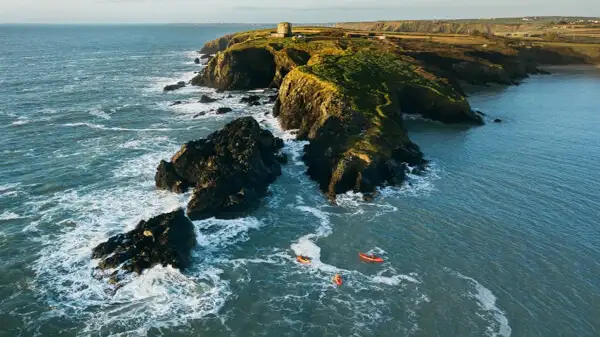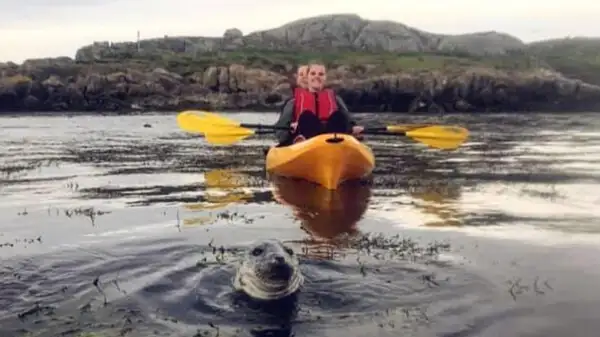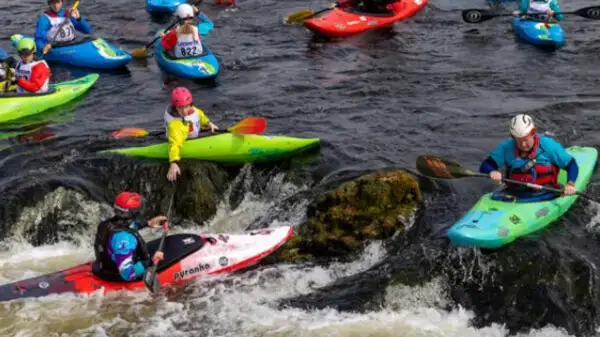You already have a kayak and wonder if it is suitable for the trip to Ireland you are planning?
Or you are planning to buy a travel kayak and wonder if it will work well for the Ireland trip and other trips?
What conditions can be expected in Ireland and what does a good travel kayak actually have to be able to do?
With the following article I would like to answer your questions and give you a good guidance for your decision:
Page Contents (click line to jump the text)

What waters are you traveling on?
If you’re leisurely paddling on a calm lake or slow-flowing river, your kayak doesn’t need to be overly fast. It can be open, or closed. Good comfort and enough space for luggage are useful. A comfortable tourer with good stability can cover that. These boats are usually relatively long with moderate width and still good maneuverability.
If you want to paddle in light whitewater, currents or surf, and perhaps have groundings with coarse stones, then you are well advised to choose a shorter, more maneuverable boat. It should be robustly finished, especially the bow and bottom, and very tilt-resistant, i.e. somewhat wider in the hull. It should also be a closed boat, so that you and your luggage do not get wet with every wave. An open boat also works if you want to paddle in a wetsuit or dry suit.
If you want to paddle long distances in stronger winds off the coast or on a big lake, your boat should be in the water rather than on the water, it should be rather narrow and long, and it should definitely be an enclosed boat with a protected interior. It is likely to be less tippy then.
If you want to do some paddling in a long-watered bay in good and calm weather with little wind and little (onshore) current, you can use practically any kayak.
But beware: Ireland’s coasts cannot be compared to the Baltic Sea: There are strong winds, strong currents and strong tides. In my view, ambitious coastal paddlers should choose a well-equipped sea kayak and explore the coasts together with a local guide.
For the purpose of this article, I would like to exclude coastal paddling and limit myself to inland waters in Ireland.
What paddling conditions can you expect in Ireland?
I have written several articles on this blog about the paddling areas in Ireland. You can basically explore the canals and smaller rivers, the Shannon with its lakes and the Erne with its lakes, as well as the lakes and canals of Northern Ireland. The Shannon alone is navigable for 220km and on the other waterways there are a few hundred kilometers more!
There we are talking mainly about calm to slightly agitated water, sheltered and open water areas, with frequent wind and occasional rain.

So your boat should be little sensitive to wind and have a good straight line with good speed. An enclosed kayak with a spraydeck is an advantage, but not a must. Fins and rudders also help to improve the straight running.
By the way, we live in Ireland (second home), originally coming from Germany. We have traveled the island again and again over many years and therefore know it very well.
How much luggage do you want to carry when paddling?
You can, of course, do a round trip by car and go paddling for an hour or two whenever you come across a nice lake or river – then you won’t need much storage space for luggage.
If you’re doing a multi-day trip without a tent and staying in B&Bs or hostels, you’ll need a bit more space in the boat.
And if you’re traveling with a tent, camping gear, and food for several days, you’ll need to load quite a bit of luggage into your kayak.
With more luggage you need a kayak with more space and more payload. The maximum allowable load is stated in the manufacturer’s specifications.
For example, if you weigh 80kg and your luggage weighs another 30kg, then you need a boat with a maximum load of at least 110kg, better 120-140kg.
However, more is not always better: if you weigh only 60kg and carry no luggage, a 120-140kg boat will not lie very deep in the water with you and can therefore be quite susceptible to wind.
So your kayak should fit you and your load as well as possible in terms of space and payload.
Are you paddling alone, with two, or both?
There are open air kayaks that you can paddle alone or with two people. To do this, you just need to add a seat in the middle, or two seats, front and back.
If you are big and heavy with a lot of payload, this can be the perfect boat for your trip alone! And two lighter people with little payload can be just as happy with this.
These 2-person boats are mostly quite long, which is good for straight running for now.
How much paddling experience do you have?
“Length runs and width brakes”. This general boating wisdom already describes what you should pay attention to when it comes to hull dimensions. In most cases, long and narrow boats are significantly faster than short and wide boats. The easier you get up to speed, the less sensitive you are to wind or currents.
But again, there are two sides to the coin: If a boat is a little wider in the middle, it has greater initial stability, so it’s less tippy, which is especially helpful for less experienced paddlers. After all, you want to sit on top and paddle dry and not keep involuntarily swimming.
A wider boat usually also has more storage space for luggage.

How will you travel – by plane or by car and ferry?
If you are using a hard-shell kayak, the only option is to travel by car. In most cases you will have to transport the kayak on the roof rack.
The advantage of this is that you can use the interior space for your other luggage or passengers. The disadvantage: The kayak on the roof causes a lot of air resistance and on long highway trips you will need much more fuel than without.
An airboat, hybrid or folding kayak, you can easily transport in the trunk. Depending on weight and packing size, you can also take the train, the intercity bus or the airplane. With the airplane you can register sports luggage, which is even relatively cheap depending on the airline.
Advantages and disadvantages of air kayaks
Cheap “swim boats” are not very robust, not very stable and not very suitable for touring. If you are willing to spend more money, you can get a top processed, robust, stable and relatively fast kayak, which is suitable for touring and still easy to transport.
Advantages of air kayaks (inflatables) are the generally good stability, the easy and fast assembly and the versatility. They come in single, double, or triple, with or without splash guards, and are flexibly convertible. They can tolerate occasional grounding and are also easy to repair in the event of a hole. There are very stiff models with drop stitch bottoms, which are driven with high air pressures. These models are then also quite fast. If you can find a model with a good fit, they are comfortable on longer trips.
Disadvantages: You sit more on the water than in it and the air tubes make for a relatively high build. This means that air kayaks are always a bit more sensitive to wind than folding kayaks or rigid hull boats. The relatively flat bottom requires clip-on fins for good straight running. The air tubes need space, so either the interior space is limited, or the boats are slightly wider than fixed hulls.
Advantages and disadvantages of folding kayaks
Folding kayaks have been around for ages – they are and have been the quintessential travel boat. For good reason, because they have many good features.
Advantages of folding kayaks: the internal framework of the folding kayak allows to build shapes with pronounced bow and stern. Tensioning devices make these boats very stable in shape and their riding characteristics are very reminiscent of rigid hull boats. Due to the deeper seat, the center of gravity is lower. Folding kayaks can therefore be built narrower than inflatable boats and are therefore usually fast and less sensitive to wind. Because of the thin outer skin, they offer a lot of cargo space. However, since the inner frame is usually made of steel and aluminum, they suffer a lot from salt water. But we are talking about inland waters here and there is no problem.
Disadvantages of folding kayaks: Assembly is usually more difficult and lengthy than with air kayaks. If a strut breaks, a repair solution can save over the vacation, but usually only a suitable spare part helps. The firmer hull does not give much when grounded, so it can be damaged more easily.
Advantages and disadvantages of foldable- or Origami kayaks
There are now great “Foldable” folding kayaks, which do not consist of a frame and outer skin, but of multilayer plastic panels with a honeycomb core. These are folded like an origami udn are very quickly assembled.
Advantages: Because the wall is relatively stiff, they offer similar handling characteristics to a “skin-on-frame” folding kayak, so they are relatively fast. Assembly is usually quick and easy, and these boats are usually very light,
Disadvantages: they are not quite as stiff as a folding kayak with a frame and skin. Robustness and fatigue strength are also somewhat lower.

Advantages and disadvantages of hybrid kayaks
Hybrid kayaks refer to inflatable boats that are stiffened and shaped by a linkage in the bottom.
Advantages of hybrid kayaks: the internal frame allows you to build stiffer inflatable boats with a more pronounced bow and stern that run faster. Construction is hardly more complex than for an airboat, and handling characteristics are often a cut above those of a pure airboat.
Disadvantages: Construction takes a bit longer, the boat becomes a bit more sensitive to grounding, and speeds are a bit higher than the airboat but much slower than the folding boat.
Advantages and disadvantages of hard-shell kayaks
Adhesive-shell kayaks still have their place.
Advantages: The handling characteristics of an average PE kayak are usually much better than those of any inflatable boat, and usually still better than a folding boat. These boats offer optimized hull shapes for every purpose. Touring boats are a good compromise between stability and speed, often have waterproof luggage compartments front and back, and can easily tolerate groundings. They are sturdy, simple and there is no superstructure. In addition, such a boat tends to cost less than a high-end inflatable or folding boat.
Disadvantages: You need a car with a roof rack to transport it, and you can’t use public transportation. The rounder profile generally results in less initial stability. Touring kayaks seem a bit more tippy.

Advantages and disadvantages of dismountable or segment-hardshell kayaks
There are also rigid hull kayaks in dismountable design, so you can transport them in the car.
Advantages: Riding characteristics on inland waters are comparable to a rigid-hull boat and much better than air or hybrid boats.
Disadvantages: Higher price, higher weight, less stability because the connections of the hull pieces can be damaged. Also, only one disassembled kayak fits in an average station wagon, then it’s full. Public transport does not work with it.
Comparison of kayak designs and features
The ideal boat does not exist, but the best possible boat for your purpose does. All the boats mentioned are suitable for your trip to Ireland and many other trips.
To make your decision a little bit easier, I compare the characteristics of the different designs.
A plus sign means “applies a little less” and four plus signs mean “applies especially strongly”. It may be that the table is not displayed in full width – then please swipe to the right or scroll.
| Portability | Speed | Stability | Robustness | Load | Examples | |
| Inflatable-Kayak | ++++ | ++ | ++++ | +++ | ++ | Gumotex Framura or Grabner Escape |
| Hybrid-Kayak | ++++ | ++ | ++++ | ++ | ++ | Nortik Scubi 1 or 1XL |
| Foldable Kayak (Skin and frame) | +++ | +++ | +++ | ++ | +++ | Pakayak Bluefin or Pakboats Quest |
| Foldable Origami-Kayak | +++ | +++ | +++ | ++ | +++ | Nortik Fold or FoldYakOne |
| Hardshell Kayak in Segments | ++ | ++++ | ++ | +++ | ++++ | Kayak Innovations Natseq or Pakayak Bluefin |
| Hardshell Kayak | + | ++++ | ++ | ++++ | ++++ | Prijon Enduro or Point65 XO13 |
Conclusion
In Ireland and many other, e.g. Scandinavian areas, you will have to deal with calm to slightly agitated water.
A spraydeck is advantageous, but not absolutely necessary. You want a kayak with good straight line running, which you can paddle well over longer distances. It should also not be too tippy and have room for luggage.
Speed is more important on an open lake with wind than on a smaller more sheltered river or canal. But it should be a good cruising speed.
When traveling, do you always take the car, or sometimes the train, bus or plane? You can think about that.
If you now think about which of the mentioned features are most important for you, you are already a big step further in choosing your travel kayak.
Whatever you decide, have fun paddling and a great vacation in Ireland!
More interesting articles for you
YOUR COMPLETE PACKING LIST FOR A HIKING PADDLING TRIP ON IRELAND’S INLAND WATERS
WHERE CAN I GO IN IRELAND FOR A MULTI-DAY HIKING PADDLING TRIP – KAYAKING ON IRELAND’S INLAND WATERS
YOUR COMPLETE PACKING LIST FOR A MULTI-DAY PADDLING TOUR ON IRELAND’S INLAND WATERS
ADVENTURE IRELAND – WITH THE PACKRAFT ON THE RIVER BARROW
cover photo credit: photo by Filip Mroz on Unsplash